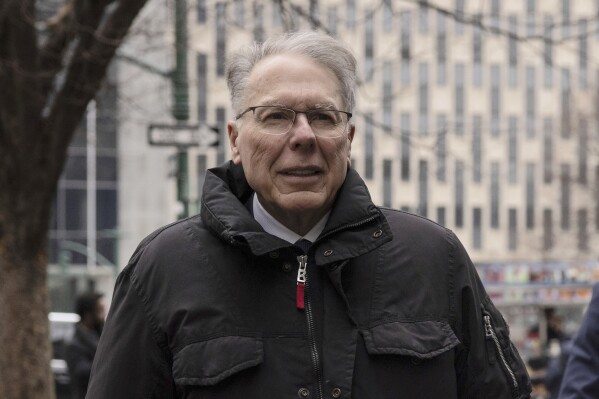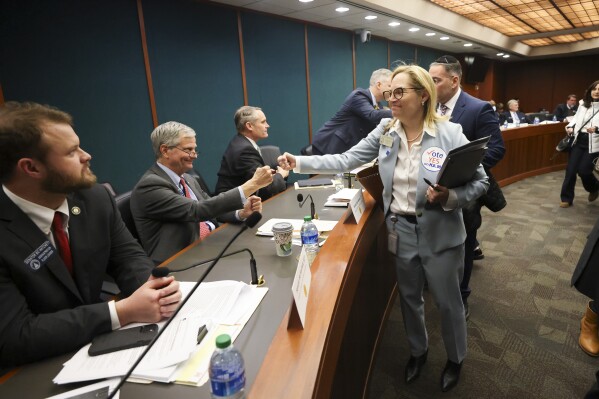Investigators detail how an American Airlines jet crossed a runway in front of a Delta plane at JFK
The pilots of an American Airlines plane taxied across the wrong runway last year in New York — into the path of another jetliner that was taking off — after the captain became distracted and confused about takeoff instructions and the co-pilot lost track of their plane’s location, according to documents released Monday.
Disaster was averted because an air traffic controller — using an expletive — shouted at pilots of the other plane, a Delta Air Lines flight, to abort their takeoff.
The National Transportation Safety Board released documents related to its investigation of the Jan. 13, 2023, incident at John F. Kennedy International Airport. The investigation is continuing, and the board said it has not yet determined a probable cause for the close call.
The nighttime incident was among several close calls at U.S. airports that alarmed the public and lawmakers and led the Federal Aviation Administration to hold a “safety summit” last year.



The pilots of the London-bound American Airlines Boeing 777 took a wrong turn on a taxiway alongside two perpendicular runways. The crew had first planned for a takeoff from runway 31L. However, they later got instructions from a controller and a message on their cockpit computer telling them to taxi across 31L and take off from runway 4L.
In later interviews, “all three pilots (on the American Airlines plane) said they understood at that time that (the flight) would be departing runway 4L,” according to the NTSB.
Instead, they crossed 4L just as a Delta Boeing 737 began its takeoff roll down the same runway.
The captain, Michael Graber, said that as the plane crossed the middle of runway 4L, he saw red runway lights turn on — the lights warn pilots when it’s not safe to be on the runway.
“All of a sudden I saw that red glow and I just — right away I said something — that ain’t right,” he told investigators. “I didn’t know what was happening, but I was thinking something’s wrong.”
The captain added power to speed across.
Graber told investigators that he heard and understood the directions from the controller but got distracted by a heavy workload and, in his mind, might have gone back to thinking they were taking off from the other runway.
The co-pilot, Traci Gonzalez, said she knew the entire time that they were supposed to cross runway 31L, “but she was unaware of the airplane’s position when the captain taxied onto runway 4L,” investigators wrote. “She knew they were approaching a runway, but she did not realize they were approaching runway 4L.”
The co-pilot also blamed distractions, including an unusually high number of weather alerts.
The third person in the cockpit, Jeffrey Wagner, a relief pilot for the long international flight, said he was “heads down” and didn’t know where the plane was as it taxied on to the runway. He said that when they crossed the wrong runway and he saw a plane to his right, he initially thought it might be taxiing behind them.
The Delta pilots, warned by the air traffic controller, were able to brake to a stop. The planes were never closer than about 1,000 feet (300 meters) apart — not a comforting margin in aviation-safety terms.
A controller warned the American crew about a “possible pilot deviation,” and gave them a phone number to call, which the captain did. After a delay, they took off for London — this time on runway 31L. The crew did not report the incident to American Airlines before taking off.
The cockpit voice recording from inside the American plane was taped over during the six-hour flight to London and lost forever.
Investigators said they tried several times to interview the American pilots, but the pilots refused on advice of their union, which objected to the NTSB recording the interviews. The NTSB then took the highly unusual step of issuing a subpoena to compel the crew members to sit for recorded interviews.
The pilots’ union, the Allied Pilots Association, had no immediate comment Monday on the NTSB documents.
The report renewed recommendations that the Federal Aviation Administration require better preservation of cockpit voice recordings. They run on loops that typically tape over old sounds after two hours. The FAA finally bowed to NTSB pressure late last year, announcing that it would propose that recordings not be overwritten for 25 hours — but only on new planes.
Disclaimer: The copyright of this article belongs to the original author. Reposting this article is solely for the purpose of information dissemination and does not constitute any investment advice. If there is any infringement, please contact us immediately. We will make corrections or deletions as necessary. Thank you.




